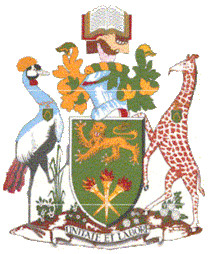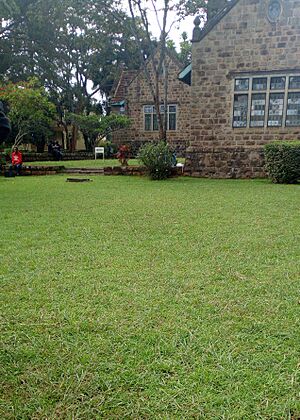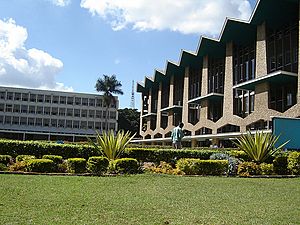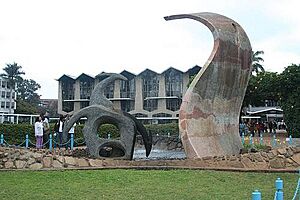University of Nairobi facts for kids

Coat of Arms of the University
|
|
|
Former name
|
|
|---|---|
| Motto | Latin: Unitate et labore |
|
Motto in English
|
"In unity and work" |
| Type | Public |
| Established | 1 July 1970, as University of Nairobi |
|
Parent institution
|
Formerly the University of London and the University of East Africa |
| Chancellor | Prof. Patrick Verkooijen |
| Vice-Chancellor | Professor Margaret Hutchinson(Ag) |
| Undergraduates | 35,897 |
| Postgraduates | 11,003 |
| Address |
University Wy, Nairobi, Kenya
,
,
Kenya
1°16′47″S 36°49′00″E / 1.27972°S 36.81667°E |
| Campus | Urban |
| Colors | Sky blue |
| Affiliations | ACU |
The University of Nairobi (often called UoN) is a large research university located in Nairobi, Kenya. It is the biggest university in Kenya. Even though it started as an educational place in 1956, it became its own independent university in 1970. Before that, it was part of the University of East Africa. In 1970, that larger university split into three separate universities: one in Uganda, one in Tanzania, and the University of Nairobi in Kenya.
In the 2023 school year, the university had over 49,000 students. About 35,000 of these were undergraduates (students studying for their first degree). Over 11,000 were postgraduates (students studying for advanced degrees like master's or PhDs). The university has created new ways for students to pay for their studies. This helps more people get a university education in Kenya.
Contents
How the University Started
The idea for the University of Nairobi began in 1956. It started as the Royal Technical College. This college first welcomed students in April 1956. They came to study technical subjects.
On June 25, 1961, the Royal Technical College changed its name to the Royal College of Nairobi. It became the second university college in East Africa. It worked with the University of London. Students could study Arts, Science, and Engineering and earn degrees from the University of London. Other subjects, like Architecture, offered diplomas.
On May 20, 1964, the Royal College of Nairobi was renamed University College Nairobi. It became part of the Federal University of East Africa. Students then earned degrees from the University of East Africa. Finally, in 1970, it became the first national university in Kenya. It was officially named the University of Nairobi.
The University of Nairobi is ranked as the top university in Kenya. It is also ranked 7th in Africa and among the top universities worldwide.
A Look at the University's History
The idea for a higher learning institution in Kenya began in 1947. The government at that time wanted to build a technical and business institute in Nairobi. By 1949, this plan grew into a bigger idea. It aimed to provide advanced technical education for Kenya. In September 1951, the Royal Technical College, Nairobi, was officially created. Its foundation stone was laid in April 1952.
Around the same time, the Asian community also planned to build a college. This college would focus on Arts, Science, and Commerce. It was meant to honor Mahatma Gandhi. To avoid building two similar colleges, the Gandhi Memorial Academy Society joined forces with the government. So, the Gandhi Memorial Academy became part of the Royal Technical College, Nairobi, in April 1954. The college then opened its doors to students in April 1956.
After students arrived, people started looking closely at how higher education worked in Kenya. In 1958, a group suggested changes. Because of their advice, the Royal Technical College, Nairobi, changed again. On June 25, 1961, it became the second university college in East Africa. It was then called "Royal College Nairobi."
On May 20, 1964, the Royal College Nairobi was renamed "University College, Nairobi." At this point, it prepared students for bachelor's degrees from the University of London. It also continued to offer college diploma programs. This continued until 1966. After that, it mainly prepared students for degrees from the University of East Africa.
On July 1, 1970, the University of East Africa was dissolved. This meant Kenya, Uganda, and Tanzania each got their own national universities. This is how the University of Nairobi was created by a special law. Since 1970, the university has grown a lot. It started with about 2,700 students and now serves over 68,000 students.
In 2001, the first Confucius Institute in Africa opened at the University of Nairobi. This was a partnership with Tianjin Normal University in China.
What the University Offers
The University of Nairobi is an official organization. It operates under Kenya's Universities Act of 2012.
Through special programs (called module II and III), thousands of Kenyans and people from other countries, especially Sudan, can study there. These students pay for their education. This helps people who meet the university's entry requirements but could not get into regular programs. Regular programs have limited spots because the government provides less funding for them. Besides regular day, evening, and weekend classes, the university also holds classes at its centers in different county headquarters across the country.
The university is also accepting students for courses at the proposed Koitalel Arap Samoei University College. These courses include law, business management, and education. They started in January 2015. This is a joint project between the County Government of Nandi and the University of Nairobi.
How the University is Organized
The university made big changes in 1983. It created six colleges, each with its own leader. This helped manage the university better. Later, in 2021, the university changed again. It now has faculties led by Deans, and the college system was phased out.
University Faculties
- Veterinary Medicine
- Arts & Social Sciences
- Science and Technology
- Law
- Agriculture
- Business and Management Science
- Education
- Engineering
- Built Environment and Design
- Health Sciences
University Departments
- Agricultural Economics
- Food Science, Nutrition And Technology
- Land Resource Management And Agricultural Technology
- Plant Science & Crop Protection
- Linguistics, Languages and Literature
- History and Archeology
- Philosophy and Religious Studies
- Library and Information
- Art and Design
- Architecture
- Real Estate, Construction Management and Quantity Surveying
- Urban and Regional Planning
- Business Administration
- Finance & Accounting
- Management Science and Project Planning
- Educational Management, Policy and Curriculum Studies
- Educational Foundations
- Educational Communication And Pedagogical Studies
- Educational and Distance Studies
- Physical Education And Sport
- Mechanical and Manufacturing Engineering
- Civil and Construction Engineering
- Electrical and Information Engineering
- Environmental and Biosystems Engineering
- Geospatial and Space Technology
- Dental Sciences
- Nursing Sciences
- Public and Global Health
- Surgery
- Human Anatomy and Physiology
- Clinical Medicine and Therapeutics
- Paediatrics and Child Health
- Obstetrics and Gynaecology
- Human Pathology
- Psychiatry
- Diagnostic Imaging and Radiation Medicine
- Medical Microbiology and Immunology
- Pharmacy
- Chemistry
- Computing and Informatics
- Mathematics
- Physics
- Biology
- Earth and Climate Sciences
- Biochemistry
- Anthropology, Gender and African Studies
- Economics, Population and Development Studies
- Sociology, Social Work and African Women Studies
- Political Science, Diplomacy and Public Administration
- Journalism and Mass Communication
- Public Health, Pharmacology and Toxicology
- Veterinary Anatomy and Physiology
- Animal Production
- Clinical Studies
- Veterinary Pathology, Microbiology and Parasitology
University Rankings
| University rankings | |
|---|---|
| Global – Overall | |
| QS World | 1001–1200 (2024) |
| THE World | 1201–1500 (2024) |
In 2023, Times Higher Education ranked the University of Nairobi among the top 1201–1500 universities worldwide.
Famous People Who Studied Here
Many notable people have studied at the University of Nairobi. Here are a few:
- Kawango Agot, a researcher and expert in HIV.
- Avril, a popular singer and actress.
- Rigathi Gachagua, the current Deputy President of Kenya.
- Githinji Gitahi, a doctor and CEO of Amref Health Africa.
- Martha Koome, the Chief Justice of Kenya.
- P. L. O. Lumumba, a well-known Professor of Law.
- Wangari Maathai, who won the Nobel Peace Prize.
- Musalia Mudavadi, a former Vice President of Kenya.
- Willy Mutunga, a former Chief Justice of Kenya.
- William Ruto, the Fifth President of Kenya.
- Anne Waiguru, a former Cabinet Secretary and Governor.
See also
- List of universities in Kenya
- Education in Kenya




